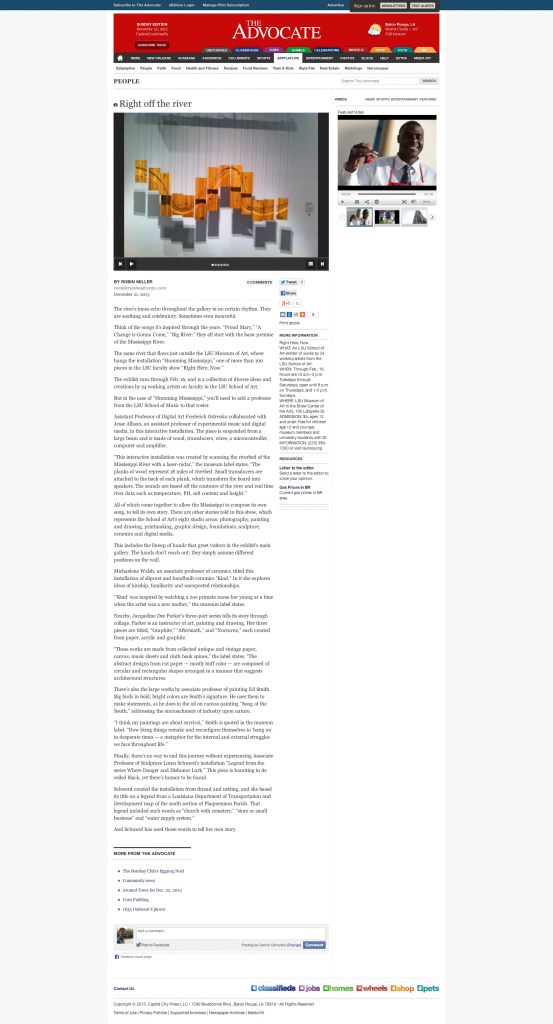The river’s tones echo throughout the gallery in no certain rhythm. They are soothing and celebratory. Sometimes even mournful.
Think of the songs it’s inspired through the years. “Proud Mary,” “A Change is Gonna Come,” “Big River:” they all start with the basic premise of the Mississippi River.
The same river that flows just outside the LSU Museum of Art, where hangs the installation “Humming Mississippi,” one of more than 100 pieces in the LSU faculty show “Right Here, Now.”
The exhibit runs through Feb. 16, and is a collection of diverse ideas and creations by 24 working artists on faculty in the LSU School of Art.
But in the case of “Humming Mississippi,” you’ll need to add a professor from the LSU School of Music to that roster.
Assistant Professor of Digital Art Frederick Ostrenko collaborated with Jesse Allison, an assistant professor of experimental music and digital media, in this interactive installation. The piece is suspended from a large beam and is made of wood, transducers, wires, a microcontroller, computer and amplifier.
“This interactive installation was created by scanning the riverbed of the Mississippi River with a laser-radar,” the museum label states. “The planks of wood represent 18 miles of riverbed. Small transducers are attached to the back of each plank, which transform the board into speakers. The sounds are based off the contours of the river and real time river data such as temperature, PH, salt content and height.”
All of which come together to allow the Mississippi to compose its own song, to tell its own story. There are other stories told in this show, which represents the School of Art’s eight studio areas: photography, painting and drawing, printmaking, graphic design, foundations, sculpture, ceramics and digital media.
This includes the lineup of hands that greet visitors in the exhibit’s main gallery. The hands don’t reach out; they simply assume different positions on the wall.
Michaelene Walsh, an associate professor of ceramics, titled this installation of slipcast and handbuilt ceramics “Kind.” In it she explores ideas of kinship, familiarity and unexpected relationships.
“‘Kind’ was inspired by watching a zoo primate nurse her young at a time when the artist was a new mother,” the museum label states.
Nearby, Jacqueline Dee Parker’s three-part series tells its story through collage. Parker is an instructor of art, painting and drawing. Her three pieces are titled, “Graphite,” “Aftermath,” and “Nocturne,” each created from paper, acrylic and graphite.
“These works are made from collected antique and vintage paper, canvas, music sheets and cloth book spines,” the label states. “The abstract designs from cut paper — mostly buff color — are composed of circular and rectangular shapes arranged in a manner that suggests architectural structures.
There’s also the large works by associate professor of painting Ed Smith. Big birds in bold, bright colors are Smith’s signature. He uses them to make statements, as he does in the oil on canvas painting “Song of the South,” addressing the encroachment of industry upon nature.
“I think my paintings are about survival,” Smith is quoted in the museum label. “How living things remake and reconfigure themselves to ‘hang on’ in desperate times — a metaphor for the internal and external struggles we face throughout life.”
Finally, there’s no way to end this journey without experiencing Associate Professor of Sculpture Loren Schwerd’s installation “Legend from the series Where Danger and Dishonor Lurk.” This piece is haunting in its veiled black, yet there’s humor to be found.
Schwerd created the installation from thread and netting, and she based its title on a legend from a Louisiana Department of Transportation and Development map of the south section of Plaquemines Parish. That legend included such words as “church with cemetery,” “store or small business” and “water supply system.”
And Schwerd has used those words to tell her own story.

